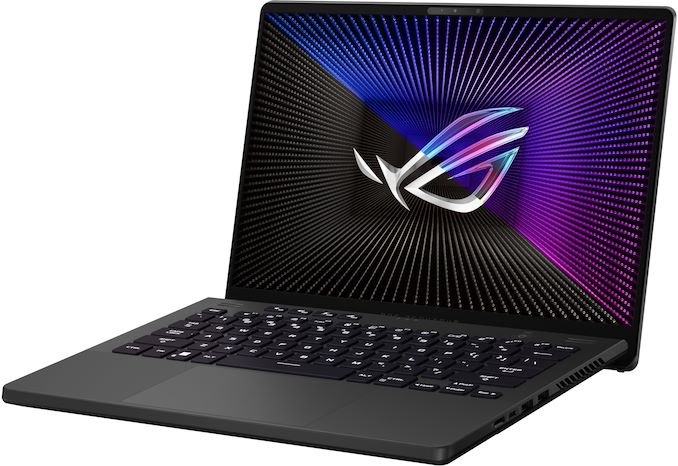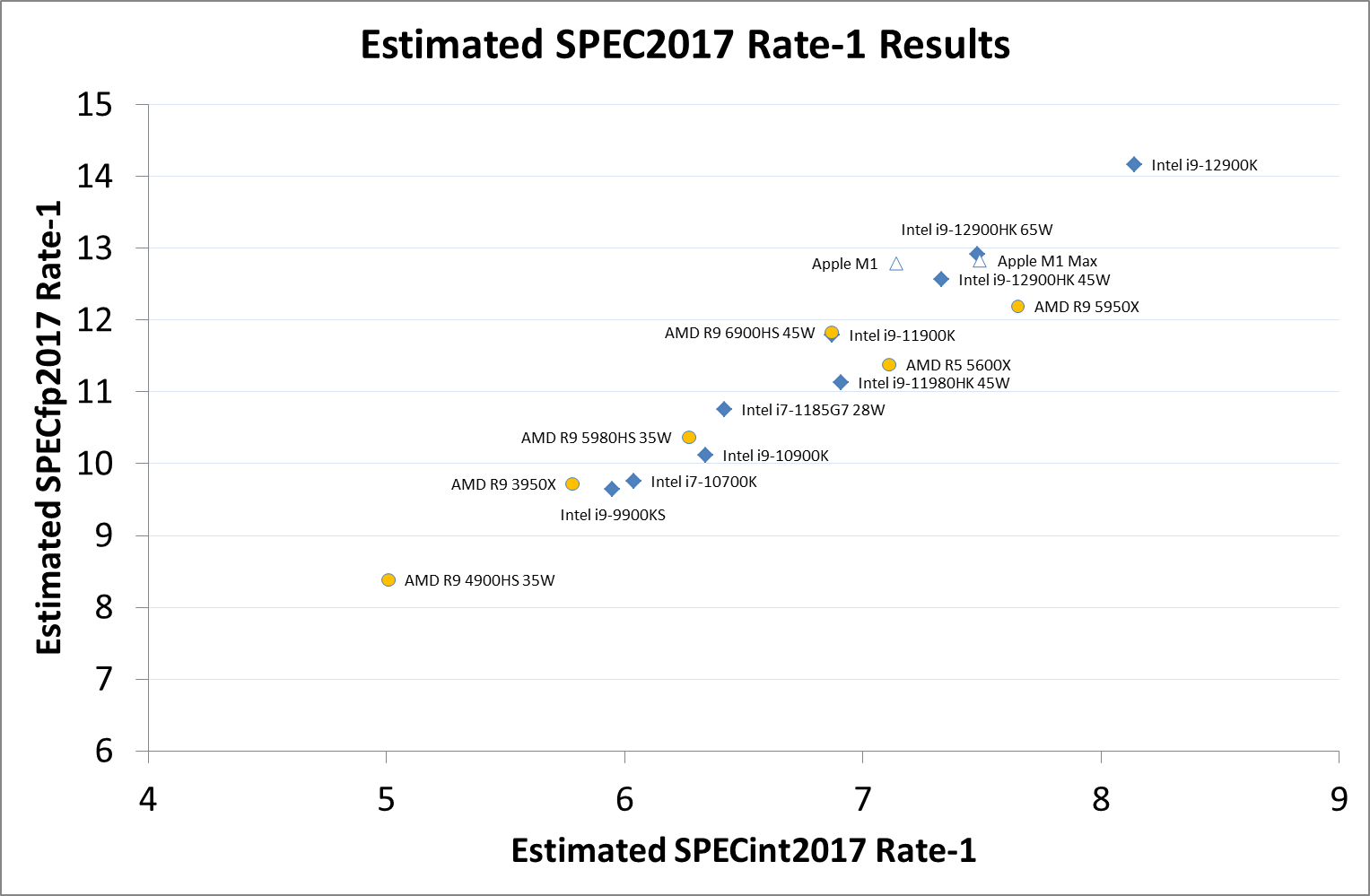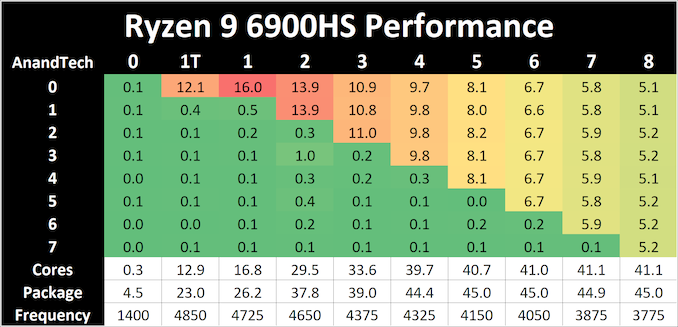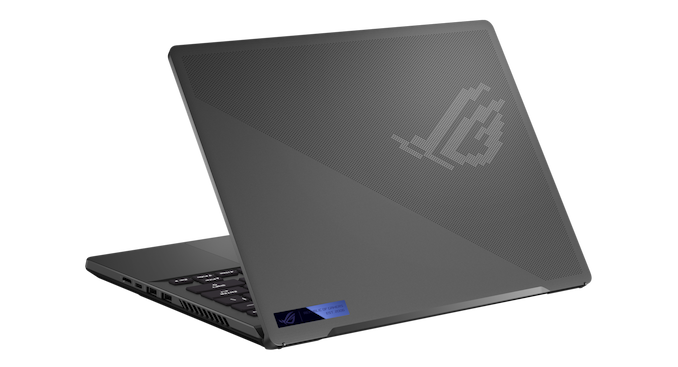AMD's Ryzen 9 6900HS Rembrandt Benchmarked: Zen3+ Power and Performance Scaling
by Dr. Ian Cutress on March 1, 2022 9:30 AM ESTConclusion
When AMD announced the new Ryzen 6000 Mobile series, codename Rembrandt, we saw a number of distinct upgrades over the previous generation: moving from TSMC 7nm to TSMC 6nm should provide a small efficiency boost, and then coupled with the move from DDR4 to DDR5 should greatly improve any memory-bound workloads. Instead of Vega graphics we now move to RDNA2 graphics, which should provide a much better gaming experience, coupled with that increased memory bandwidth. On top of that all, we were told about AMD’s 50+ updates to the SoC focused on power management, wake from sleep, and race to sleep. The one thing that we knew didn’t change was the CPU core: despite being called Zen3+, there is no difference in the microarchitecture compared to Zen3 – the reason why it gets a plus is due to the power management techniques, improved memory, and new manufacturing process.
But the fact of the matter is, CPU performance is more than just the microarchitecture and frequency. Beyond that, it’s the memory subsystem, which also contributes directly to IPC or performance per clock. This is why I’ve gone off iso-frequency testing for this sort of comparison, because each product is built with optimization points in mind, and moving simply the core frequency causes a different balance of resources compared to the ‘as built’ and ‘as sold’ metrics. This is why when we put Zen3+ up against Zen3 at a similar power level, we’re seeing a sizable uptick in performance.
In our industry standard SPEC tests, this translates to an +11.9% average increase for Zen3+ across integer and floating point in single threaded mode compared to Zen3. In multi-threaded mode at 35 W, this was a +10.4% for integer, but +32.4% for floating point. We saw a similar size jump in our multi-threaded floating point SPEC tests when Intel’s Alder Lake moved from DDR4 to DDR5, showcasing that there are key industry standard workloads for which DRAM memory bandwidth is still the limiting factor.
So while it’s a great move to see AMD jump into DDR5 with this new platform, the elephant in the room is still the performance against similar power hardware from Intel. Unfortunately we don’t have too many data points, as Brett in Canada tested the performance-focused 12900HK, and I’m the UK where I tested the efficiency-focused 6900HS, but suffice to say that in raw performance at least, comparing P cores to Zen3+ and multi-threaded workloads, Intel still has an advantage. Intel’s advantage increases when we increase the power, as it seemingly has more frequency to give, whereas AMD’s Rembrandt is already near peak all-core frequency at modest 35-45W power levels. This is showcasing one difference between the two manufacturing processes: AMD on TSMC N6, and Intel on Intel 7.
If we take something as simple as CineBench R20 (everyone’s favorite), the Intel CPU in 45 W mode scores 730, while the AMD CPU in 45 W mode scores 613, only matching Intel’s previous generation. That’s partly due to the single threaded power consumption on both platforms – while AMD is using 12.9 W on the cores (23 W package) to reach one thread at 4850 MHz, and doesn’t improve single thread performance in higher power modes, Intel does gets a performance uplift going from 45 W to 65 W, suggesting that the single thread power consumption is up in that region.
The same applies for multi-threading – in a lot of our benchmarks we see that AMD scores minor gains going from 35 W to 45 W to 65 W, indicating that the efficiency point is really around that 35 W metric. But when we scale that up to the multi-threaded tests, Intel can scale power for additional performance a lot more, but also wins as it has a total of 20 threads, compared to AMD’s sixteen. This means at the end of the day Intel can get +40% performance at the same power in benchmarks that can take advantage of its core structure, but only +14% in other tests (like SPEC) despite having +25% more cores.
While we haven’t touched battery life or graphics in this article, instead looking at CPU performance, we can see that realistically AMD is finding a good optimization point around that 35 W mark with this new Rembrandt chip. Pushing for more power gives minor performance uplifts, suggesting it isn’t really that scalable, but when we combine the new updated SoC with the move to DDR5, it’s still a great performer. In fact, both Intel and AMD chips seem to be amazing this generation, and if you’re in the market for a flagship, CPU performance is everywhere. But right now, Intel seems ahead at the high-end.
What’s going to be interesting here is testing the 15 W versions of the latest platforms. AMD still has 8 core processors, with all 8 cores being big cores, whereas Intel has moved down to 2 big cores paired with 8 efficient cores. We might see the tides shift the other direction allowing AMD to be more scalable, pushing 15 W or higher modes with more performance, while Intel relies on the efficient cores to pick up the rest of the workload. Ultimately this is where the battle really matters, as this is at the price points where most notebooks are going to be sold.
















92 Comments
View All Comments
DannyH246 - Wednesday, March 2, 2022 - link
For a laugh.Speedfriend - Wednesday, March 2, 2022 - link
Seriously, how old are you?abufrejoval - Friday, March 4, 2022 - link
It's a slow season (for computers) so they have to spread it out some. The other pieces evidently have been prepared already as parting gifts by Ian.vegemeister - Tuesday, March 1, 2022 - link
>Per-Thread Power/Clock Control: Rather than being per core, each thread can carry requirementsDoes that imply the core can change its voltage and clocking on the same timescale as switching SMT thread? I thought modern SMT was fine-grained enough that there are instructions from both threads in-flight at once.
Or is it just for simplifying the OS's cpufreq driver?
>For example, if a core is idle for a few seconds, would it be better to put in a sleep state?
A few hundred microseconds, surely?
Arnulf - Tuesday, March 1, 2022 - link
"... following AMD’s cadence of naming its mobile processors after painters"As opposed to what, their desktop lineup naming (also named after painters)? Consumer processors are named after painters.
syxbit - Tuesday, March 1, 2022 - link
>>While we haven’t touched battery life or graphics in this articlethat's pretty critical for a Laptop review.
I'm pretty tired of Intel reviews constantly covering their 12th gen superiority without talking about power. It's easy to beat a competitor if you just double the power budget. It's laughable that Intel is pretending they've caught up to Apple.
Oxford Guy - Tuesday, March 1, 2022 - link
I am sure those producing the Steam handheld would like reviewers to not test battery life.ninjaquick - Tuesday, March 1, 2022 - link
How fast do these chips perform vp9 4k decode? A major use case moving forward will be game streaming, and I'm struggling to find hardware acceleration numbers.dwillmore - Tuesday, March 1, 2022 - link
Error on page 3: "yCrundher" is a misspellingYukaKun - Tuesday, March 1, 2022 - link
Writing this from a 5900HX (Asus G17 Strix) and upgrading from a i7 7700HQ that, I have to say is really efficient for what it is, the AMD laptop is just in another league of its own. Both have a 90Wh battery and the Intel, not even new, would break the 4h mark. This thing has as much usage as my tablets with normal usage. It's really impressive and, for the go stuff, it's so SO nice. Then you need to game and it just works. The 6800M is quite the beast in its own right. Sad this thing doesn't have a mux switch, but it still works amazingly well.This preamble was just to say, I'm surprised the 6000HK isn't a lot better, but I guess it's to be expected. On paper, the 6000 mobile series has a lot of potential with PCIe4 and slightly better process. DDR5 is too new IMO to show a definitive advantage on mobile, but maybe next gen will leap. I have DDR4L 3200 with my 5900HX and I put DDR4L 2666 to the i7 7700HQ, so DDR5L needs to be way faster than the crappy 4800 MT/s JEDEC spec we have currently.
Regards.